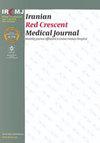Correlation Analysis between Apparent Diffusion Coefficient of Prostate Cancer and other Prostate Cancer Indicators
IF 0.2
4区 医学
Q3 MEDICINE, GENERAL & INTERNAL
引用次数: 0
Abstract
Background: There are very few reports on the correlation between the apparent diffusion coefficient (ADC) of magnetic resonance parameters and other laboratory indicators of prostate cancer in China, and there is no unified clinical conclusion at present from the other parts of the world. Therefore, this study analyzed the correlation between ADC and laboratory indicators, such as serum total prostate specific antigen (TPSA), complex prostate specific antigen (CPSA), free prostate specific antigen (FPSA), Gleason score, and left and right diameters of the prostate so as to provide a basis for the diagnosis and treatment of prostate cancer. Methods: A total of 104 patients of all age groups with prostate cancer diagnosed in the General Hospital of Wanbei Coal and Electricity Group, Wanbei, China, from January 2017 to December 2022 were retrospectively analyzed as the experimental group. At the same time, 63 patients with benign prostatic hyperplasia who received health examinations were selected as the control group. TPSA, CPSA, FPSA, CPSA/TPSA, FPSA/TPSA, Gleason score, left and right diameters of the prostate, and magnetic resonance parameter ADC were detected in all patients. At the same time, we analyzed the correlation between ADC and other parameters in prostate cancer patients. Results: The serum levels of TPSA, CPSA, and FPSA in prostate cancer patients were significantly higher (P<0.001) than in those in the control group. The differences between CPSA/TPSA and FPSA/TPSA in the two groups were not statistically significant. Meanwhile, ADC and left and right diameters of the prostate were significantly lower in prostate cancer patients than in subjects in the control group, and the differences were statistically significant (P<0.001). In addition, serum TPSA, CPSA, and FPSA in high-risk prostate cancer patients were found to be significantly higher than in cases in the medium-risk and low-risk groups. The results of our study also revealed that ADC was moderately negatively correlated with FPSA (r=-0.415, P<0.001) and weakly negatively correlated with TPSA (r=-0.222, P=0.024). Conclusion: There is a correlation between ADC, TPSA, and FPSA in patients with prostate cancer, and there were significant differences in TPSA, CPSA, and FPSA between patients with prostate cancer and patients with benign prostatic hyperplasia. The three parameters can be combined for the diagnosis of prostate cancer.前列腺癌表观扩散系数与其他前列腺癌指标的相关性分析
背景:关于磁共振参数表观扩散系数(ADC)与癌症其他实验室指标之间的相关性,国内报道很少,目前国际上尚无统一的临床结论。因此,本研究分析了ADC与血清总前列腺特异性抗原(TPSA)、复合前列腺特异性抗体(CPSA)、游离前列腺特异性蛋白(FPSA)、Gleason评分、前列腺左右径等实验室指标的相关性,为前列腺癌症的诊断和治疗提供依据。方法:回顾性分析2017年1月至2022年12月在万北煤电集团总医院确诊的104例不同年龄组的前列腺癌症患者作为实验组。同时选择63例接受健康检查的良性前列腺增生患者作为对照组。检测所有患者的TPSA、CPSA、FPSA、CPSA/TPSA、FPSA/TPSA、Gleason评分、前列腺左右径和磁共振参数ADC。同时,我们分析了前列腺癌症患者ADC与其他参数的相关性。结果:前列腺癌症患者血清TPSA、CPSA和FPSA水平显著高于对照组(P<0.001)。两组CPSA/TPSA和FPSA/TPSA的差异无统计学意义。同时,前列腺癌症患者的ADC和前列腺左右径明显低于对照组,差异有统计学意义(P<0.001),且前列腺癌症高危患者血清TPSA、CPSA和FPSA明显高于中危组和低危组。研究结果还表明,ADC与FPSA呈中度负相关(r=-0.415,P<0.001),与TPSA呈弱负相关(r=-0.222,P=0.024),以及前列腺癌症患者与良性前列腺增生患者之间的FPSA。这三个参数可以结合起来用于诊断前列腺癌症。
本文章由计算机程序翻译,如有差异,请以英文原文为准。
求助全文
约1分钟内获得全文
求助全文
来源期刊

Iranian Red Crescent Medical Journal
MEDICINE, GENERAL & INTERNAL-
CiteScore
1.16
自引率
0.00%
发文量
0
期刊介绍:
The IRANIAN RED CRESCENT MEDICAL JOURNAL is an international, English language, peer-reviewed journal dealing with general Medicine and Surgery, Disaster Medicine and Health Policy. It is an official Journal of the Iranian Hospital Dubai and is published monthly. The Iranian Red Crescent Medical Journal aims at publishing the high quality materials, both clinical and scientific, on all aspects of Medicine and Surgery
 求助内容:
求助内容: 应助结果提醒方式:
应助结果提醒方式:


